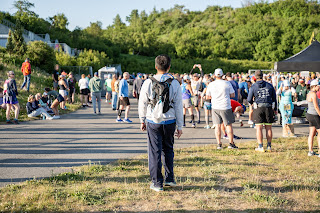For those who are unfamiliar, Asheville NC was devastated when Hurricane Helene ripped through the area in September 2024. My dear cousin Teena who lives in the area was thankfully not personally hurt or injured. In the past 6 months, the region has been slowly picking itself back up. While far being completely recovered, they have been slowly rebuilding. I've been keen to visit Teena and her family for a while. Well, the stars aligned and i happened to be free on their marathon weekend, so i booked everything up and headed over.
I think i'm late to this party, because i never realized how vibrant and interesting Asheville is. They have a very active restaurant and brewery scene, and the vibe downtown (granted, it was St. Patrick's Day weekend) is energetic. It's quite the shame that the River Arts District was ruined by all the flooding. I wish i had gotten the chance to see it the way it was, but i'm sure they will rebuild it into something better once their recovery is complete. I hope to visit again when that happens.
From a personal standpoint, i am completely unhappy with my time. I was aiming to finish under 2:30 and woefully overshot my target BY A LOT. For the most part, i feel that i was gun-shy on pushing the pace because i was afraid that i would either bonk too soon or end up hurting myself. I could kind of feel my right heel starting to ache when i ran down the downhills, and ended up just not trying to go fast on the flats or inclines. As far as bonking, it's probably an irrational fear. I've previously demonstrated (to myself more than anyone) that the run-walk-run method is an effective way of conserving energy for the latter parts of the race, all the way the 26.2. As far as injury... well, i've proven time and again that i'm entirely injury-prone with no end in sight. I am still dealing with my plantar fasciitis. It's better than it was, but still hurts after runs. Meh. I just need to put in more work and hope for the best.
(An aside: In no way am i minimizing their tragedy, but it has occurred to me that my own troubles mirror theirs. I was struck with fasciitis in September 2024 and have had a verry sloow recovery. As demonstrated by this race, i'm - ahem - half of the way there.)
RACE NOTES:
1. The expo was decent and honestly more interesting than some bigger races that i've been to. They had some local vendors sampling and selling their wares. I ended up buying a new race hat and some electrolyte mix. Not a huge sum to pump into the local economy, but every little bit counts, IMHO.
2. The weather was great, hanging out in the mid 50s and cloudy. It was a little windy (a storm was getting ready to pass through the area), but not intolerable. I barely needed my throwaway sweater and pants.
 |
| Photo credit: Gianina Chong |
3. At 1740 runners (516 for the full and 1264 for the half), this was not a miniscule race, but it was small enough to have ample parking and not need to separate runners from the spectators. Gianina and Teena basically stayed with me until i started running, and they were right there waiting for me at the end, no need for a long chute or "family reunion area."
 |
| Sadly, Asheville no longer has a Chinese buffet in the immediate area. Photo credit: Gianina Chong |
 |
| Photo credit: Gianina Chong |
 |
| Photo credit: Gianina Chong |
4. The half-marathon course was mostly run through Asheville neighborhoods. Honestly there wasn't that much to see; i wonder if it would have been prettier if they ran this in the fall. The prettier vistas may have been in the second 13.1. I really only had one beef: a lot of the roads remained open during the race. It wasn't uncommon to have cars driving down one lane while all the runners were in the other. I understand that it's a small city, so there may be limitations to how many roads they can realistically close. It was just weird and not something that i've previously experienced in any organized race. There was a decent amount of elevation gain, although there was a net elevation loss in the final analysis. I wonder how much the uphills messed with my time. Note to self: do more hill training. Good thing i spend some of my weeks in the hills of Sonora.
 |
| Dashing down a hill. Photo credit: Asheville Marathon |
 |
| Photo credit: Asheville Marathon |
5. There were only three aid stations on the half marathon course. I had to bring my own water to keep well-hydrated. There was no entertainment to speak of, except maybe for some music blaring at the aforementioned aid stations. The spectators kept us entertained with the requisite signs saying "touch here to power up," and "you run better than the government."
6. I managed to drink my "free" beer at the end of this race since the line wasn't too long (small races FTW). There wasn't enough parking at the Brewery, but luckily Teena managed to find a secret spot near enough to easily walk to.
 |
| Photo credit: Gianina Chong |
 |
| Photo credit: Gianina Chong |
Aside from having automobiles on the course, this was a decent race. I might do it again to either better my time or run the full 26.2. But really, those will just be excuses to experience the city again and visit with family.








































